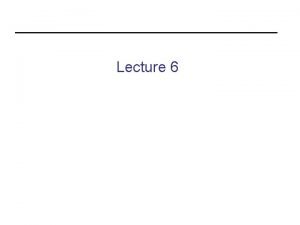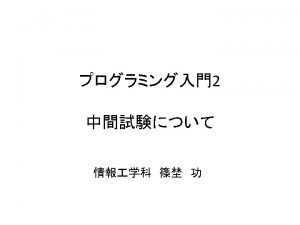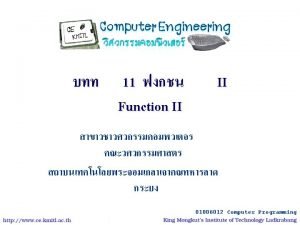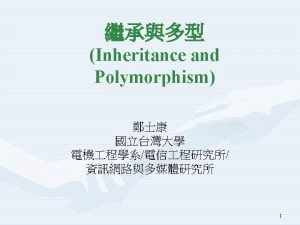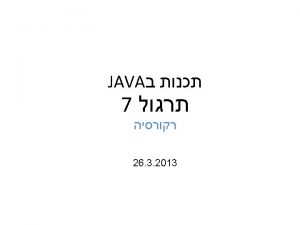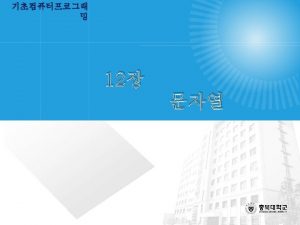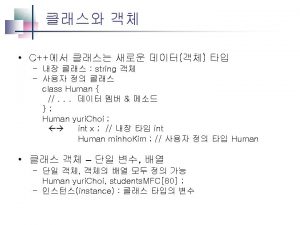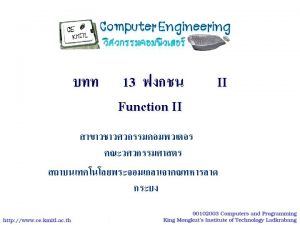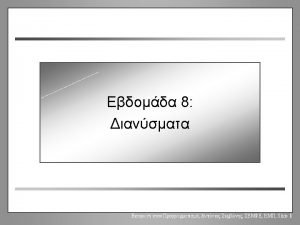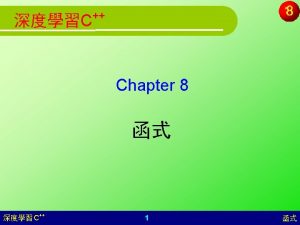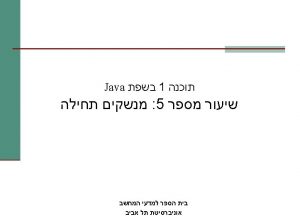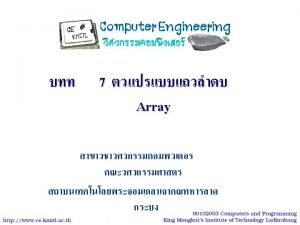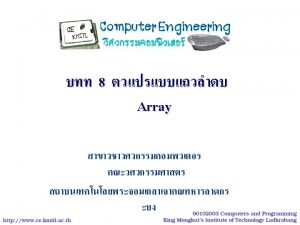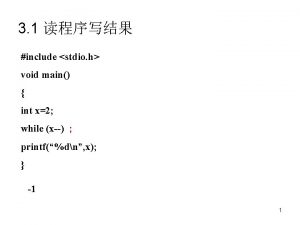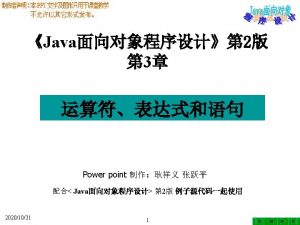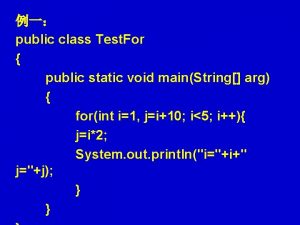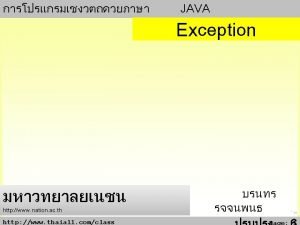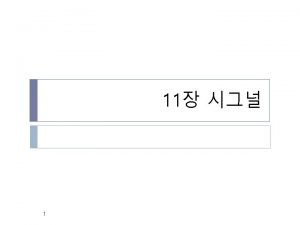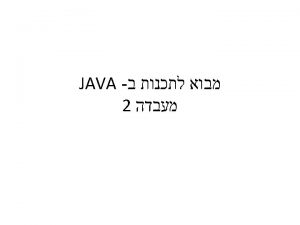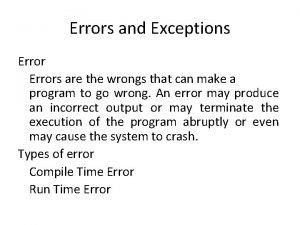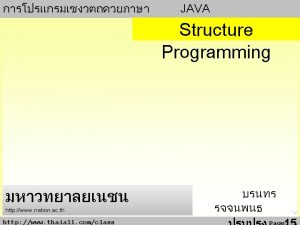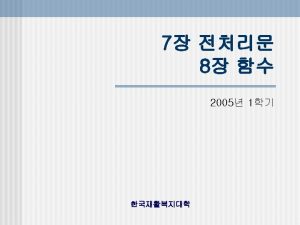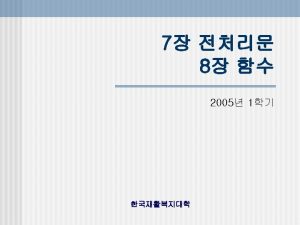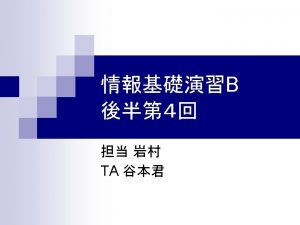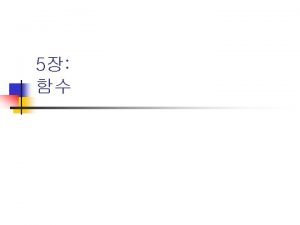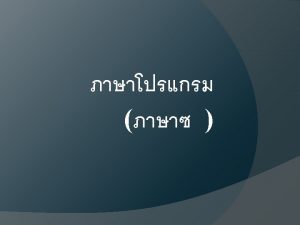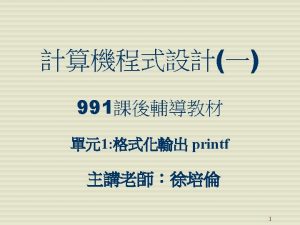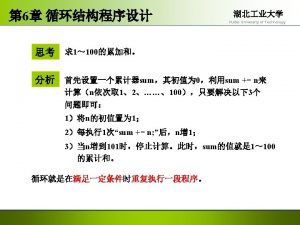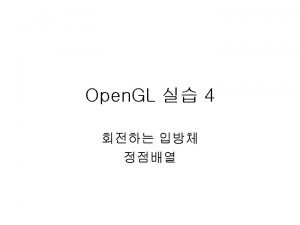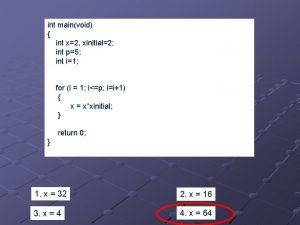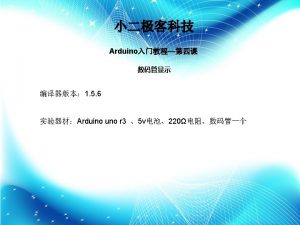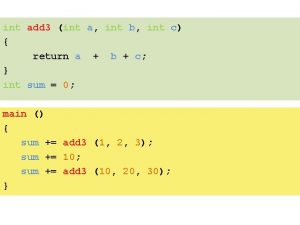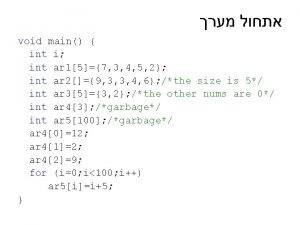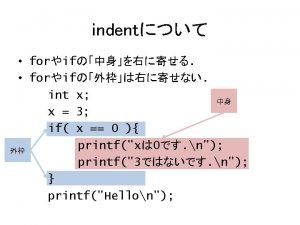1 9 4 includestdio h void main int














![1차원 배열정리 9 -4] 배열에 초기값을 대입하고 합계를 구하는 예제 수정 #include<stdio. h> void 1차원 배열정리 9 -4] 배열에 초기값을 대입하고 합계를 구하는 예제 수정 #include<stdio. h> void](https://slidetodoc.com/presentation_image_h2/6b1b86a38af4f31e15bd46a4a7042ec2/image-15.jpg)

![예제 9 -6] 10개의 정수형 자료에 10을 곱한 후 합계와 평 균을 구하라. #include 예제 9 -6] 10개의 정수형 자료에 10을 곱한 후 합계와 평 균을 구하라. #include](https://slidetodoc.com/presentation_image_h2/6b1b86a38af4f31e15bd46a4a7042ec2/image-17.jpg)
![예제 9 -6]의 실행결과 table[0] table[1] table[2] table[3] table[4] table[5] table[6] table[7] table[8] table[9] 예제 9 -6]의 실행결과 table[0] table[1] table[2] table[3] table[4] table[5] table[6] table[7] table[8] table[9]](https://slidetodoc.com/presentation_image_h2/6b1b86a38af4f31e15bd46a4a7042ec2/image-18.jpg)




![신장의 최대값 구하는 배열 프로그램 #include<stdio. h> //배열로 수정하세요 void main() { //배열명 input[] 신장의 최대값 구하는 배열 프로그램 #include<stdio. h> //배열로 수정하세요 void main() { //배열명 input[]](https://slidetodoc.com/presentation_image_h2/6b1b86a38af4f31e15bd46a4a7042ec2/image-23.jpg)

![3. 1 2차원 배열 예] int unit [3][4]; 1열 1행 행 * 열 = 3. 1 2차원 배열 예] int unit [3][4]; 1열 1행 행 * 열 =](https://slidetodoc.com/presentation_image_h2/6b1b86a38af4f31e15bd46a4a7042ec2/image-25.jpg)
![3. 1 2차원 배열 컴퓨터 기억형태 배열명: unit[0] 배열명: unit[1] 배열명: unit[2] unit [0][0] 3. 1 2차원 배열 컴퓨터 기억형태 배열명: unit[0] 배열명: unit[1] 배열명: unit[2] unit [0][0]](https://slidetodoc.com/presentation_image_h2/6b1b86a38af4f31e15bd46a4a7042ec2/image-26.jpg)











![2차원배열예제 3] 학생 세명의 총점과 합계 #include <stdio. h> main(void) { int i, j, 2차원배열예제 3] 학생 세명의 총점과 합계 #include <stdio. h> main(void) { int i, j,](https://slidetodoc.com/presentation_image_h2/6b1b86a38af4f31e15bd46a4a7042ec2/image-38.jpg)
![2차원배열 행 합계 실습평가1 #include <stdio. h> main(void) { int day[3][5 = {{12, 56, 2차원배열 행 합계 실습평가1 #include <stdio. h> main(void) { int day[3][5 = {{12, 56,](https://slidetodoc.com/presentation_image_h2/6b1b86a38af4f31e15bd46a4a7042ec2/image-39.jpg)
![2차원배열 행 합계 실습평가2 #include <stdio. h> main(void) { int day[3][5] ={{12, 56, 32, 2차원배열 행 합계 실습평가2 #include <stdio. h> main(void) { int day[3][5] ={{12, 56, 32,](https://slidetodoc.com/presentation_image_h2/6b1b86a38af4f31e15bd46a4a7042ec2/image-40.jpg)


![예제 9 -14] 10명의 3과목 성적을 초기화하여 입력 후 과목별 평균을 구하는 프로그램 #include 예제 9 -14] 10명의 3과목 성적을 초기화하여 입력 후 과목별 평균을 구하는 프로그램 #include](https://slidetodoc.com/presentation_image_h2/6b1b86a38af4f31e15bd46a4a7042ec2/image-43.jpg)







![홀수 합 • #include <stdio. h> • • main(void) { • int day[10] ={1, 홀수 합 • #include <stdio. h> • • main(void) { • int day[10] ={1,](https://slidetodoc.com/presentation_image_h2/6b1b86a38af4f31e15bd46a4a7042ec2/image-51.jpg)
- Slides: 51














![1차원 배열정리 9 4 배열에 초기값을 대입하고 합계를 구하는 예제 수정 includestdio h void 1차원 배열정리 9 -4] 배열에 초기값을 대입하고 합계를 구하는 예제 수정 #include<stdio. h> void](https://slidetodoc.com/presentation_image_h2/6b1b86a38af4f31e15bd46a4a7042ec2/image-15.jpg)
1차원 배열정리 9 -4] 배열에 초기값을 대입하고 합계를 구하는 예제 수정 #include<stdio. h> void main() { int m[5]; int a, sum=0; for(a=0; a<5; a++) { printf("input number: "); scanf("%d", &m[a]); //scanf()으로 배열원소 값을 초기화 printf("m[%d] = %dn", a, m[a]); sum = sum + m[a]; } printf("sum = %dn", sum); }

![예제 9 6 10개의 정수형 자료에 10을 곱한 후 합계와 평 균을 구하라 include 예제 9 -6] 10개의 정수형 자료에 10을 곱한 후 합계와 평 균을 구하라. #include](https://slidetodoc.com/presentation_image_h2/6b1b86a38af4f31e15bd46a4a7042ec2/image-17.jpg)
예제 9 -6] 10개의 정수형 자료에 10을 곱한 후 합계와 평 균을 구하라. #include <stdio. h> main( ) { int table[10] = {24, 35, 43, 25, 36, 56, 46, 37, 48, 29}; int total = 0; float average; int index ; for (index = 0; index < 10; index++) table[index] = table[index] * 10; //배열 값에 10을 곱한다 for (index = 0; index <= 10; index++) total = total + table[index]; { //배열 값을 더한다 printf(“table[%d] = %dn", index, table[index]); } printf(" 전체 합계 : %dn", total); average = (float) total / 10; printf(" 평 균 : %3. 2 fn", average); printf(" 배열 table[0]의 번지 ==> %dn", &table[0]); //배열의 첫번째 원소의 시작주소 printf(" 배열 table의 시작 번지 ==> %dn", table); } //배열명의 시작주소
![예제 9 6의 실행결과 table0 table1 table2 table3 table4 table5 table6 table7 table8 table9 예제 9 -6]의 실행결과 table[0] table[1] table[2] table[3] table[4] table[5] table[6] table[7] table[8] table[9]](https://slidetodoc.com/presentation_image_h2/6b1b86a38af4f31e15bd46a4a7042ec2/image-18.jpg)
예제 9 -6]의 실행결과 table[0] table[1] table[2] table[3] table[4] table[5] table[6] table[7] table[8] table[9] = = = = = 24 35 43 25 36 56 46 37 48 29 *10 *10 *10




![신장의 최대값 구하는 배열 프로그램 includestdio h 배열로 수정하세요 void main 배열명 input 신장의 최대값 구하는 배열 프로그램 #include<stdio. h> //배열로 수정하세요 void main() { //배열명 input[]](https://slidetodoc.com/presentation_image_h2/6b1b86a38af4f31e15bd46a4a7042ec2/image-23.jpg)
신장의 최대값 구하는 배열 프로그램 #include<stdio. h> //배열로 수정하세요 void main() { //배열명 input[] int input[5] , i , max=0; for(i=0; i<5; i++) { scanf("%d", &input[i]); if( max < input[i]) max = input[i] ; printf("두 값 %d : %d 비교해서 n", max, input[i]); } printf(" 최대 신장은 =%dcm입니다 n", max); }

![3 1 2차원 배열 예 int unit 34 1열 1행 행 열 3. 1 2차원 배열 예] int unit [3][4]; 1열 1행 행 * 열 =](https://slidetodoc.com/presentation_image_h2/6b1b86a38af4f31e15bd46a4a7042ec2/image-25.jpg)
3. 1 2차원 배열 예] int unit [3][4]; 1열 1행 행 * 열 = 기억장소 크기 2열 3열 4열 unit [0][0] unit [0][1] unit [0][2] unit [0][3] 2행 unit [1][0] unit [1][1] unit [1][2] unit [1][3] 3행 unit [2][0] unit [2][1] unit [2][2] unit [2][3]
![3 1 2차원 배열 컴퓨터 기억형태 배열명 unit0 배열명 unit1 배열명 unit2 unit 00 3. 1 2차원 배열 컴퓨터 기억형태 배열명: unit[0] 배열명: unit[1] 배열명: unit[2] unit [0][0]](https://slidetodoc.com/presentation_image_h2/6b1b86a38af4f31e15bd46a4a7042ec2/image-26.jpg)
3. 1 2차원 배열 컴퓨터 기억형태 배열명: unit[0] 배열명: unit[1] 배열명: unit[2] unit [0][0] [0][1] [0][2] [0][3] 첫번째 주소값: 0000 unit unit [1][0] [1][1] [1][2] [1][3] [2][0] [2][1] [2][2] [2][3] 0012 + 4 = 0016 0000 + 4 = 0004 + 4 = 0008 + 4 = 0012 0016 + 4 = 0020 + 4 = 0024 + 4 = 0030 + 4 = 0034 + 4 = 0038 + 4 = 0042 + 4 = 0046











![2차원배열예제 3 학생 세명의 총점과 합계 include stdio h mainvoid int i j 2차원배열예제 3] 학생 세명의 총점과 합계 #include <stdio. h> main(void) { int i, j,](https://slidetodoc.com/presentation_image_h2/6b1b86a38af4f31e15bd46a4a7042ec2/image-38.jpg)
2차원배열예제 3] 학생 세명의 총점과 합계 #include <stdio. h> main(void) { int i, j, sum=0; int a[3][3] = {{67, 89, 78}, {90, 90}, {90, 98}}; for( i=0; i<3; i++) { for( j=0; j<3; j++) { sum = sum + a[i][j]; } } } printf("행의 전체 합계 = %d n", sum);
![2차원배열 행 합계 실습평가1 include stdio h mainvoid int day35 12 56 2차원배열 행 합계 실습평가1 #include <stdio. h> main(void) { int day[3][5 = {{12, 56,](https://slidetodoc.com/presentation_image_h2/6b1b86a38af4f31e15bd46a4a7042ec2/image-39.jpg)
2차원배열 행 합계 실습평가1 #include <stdio. h> main(void) { int day[3][5 = {{12, 56, 32, 15, 88}, {99, 66, 77, 88, 60}, {65, 5, 18, 22, 0}}; int i, j, sum=0; // for 문장으로 행과 열 반복 for(i=0; i<3; i++ ){ for(j=0; j<5; j++){ printf(" day[%d]= %dn" , i, j, day[i][j]); sum = sum + day[i][j]; } printf("%d 행의 합계 = %dn", i+1, sum); sum = 0; printf("n"); } }
![2차원배열 행 합계 실습평가2 include stdio h mainvoid int day35 12 56 32 2차원배열 행 합계 실습평가2 #include <stdio. h> main(void) { int day[3][5] ={{12, 56, 32,](https://slidetodoc.com/presentation_image_h2/6b1b86a38af4f31e15bd46a4a7042ec2/image-40.jpg)
2차원배열 행 합계 실습평가2 #include <stdio. h> main(void) { int day[3][5] ={{12, 56, 32, 15, 88}, {99, 66, 77, 88, 60}, {65, 5, 18, 22, 0}}; int i, j, sum=0; // for 문장으로 행과 열 반복 for(i=0; i<3; i++ ){ for(j=0; j<5; j++){ printf(" day[%d]= %dn" , i, j, day[i][j]); sum = sum + day[i][j]; } //printf("%d 행의 합계 = %dn", i+1, sum); } printf("sum = %d n", sum); }


![예제 9 14 10명의 3과목 성적을 초기화하여 입력 후 과목별 평균을 구하는 프로그램 include 예제 9 -14] 10명의 3과목 성적을 초기화하여 입력 후 과목별 평균을 구하는 프로그램 #include](https://slidetodoc.com/presentation_image_h2/6b1b86a38af4f31e15bd46a4a7042ec2/image-43.jpg)
예제 9 -14] 10명의 3과목 성적을 초기화하여 입력 후 과목별 평균을 구하는 프로그램 #include <stdio. h> #define MAN 10 // 학생수 #define COURSE 3 // 과목수 main( ) { int score[MAN][COURSE] = {{100, 80, 70}, {30, 90, 54}, {76, 82, 69}, {56, 88}, {38, 40, 66}, {66, 72, 78}, {72, 78, 90}, {92, 94, 100}, {80, 84}, {86, 88, 94}}; int total[COURSE] = {0, }; float average[COURSE]; int row, column , count = 0; for (row = 0; row < MAN; row++) for (column = 0; column < COURSE; column++) total[column] += score[row][column]; while (count < COURSE) { average[count] = total[count] / (float) MAN; printf(“<%d번 과목>합계=%d 평균= %5. 2 f n", count + 1, total[count], average[count]); count++; } } 2022 -01 -12 종이위에 쓰는 C 프로그래밍 43





문자열 배열의 초기화 #include<stdio. h> #include<string. h> //strcpy() 사용하여 배열 초기화 void main() { char b[10] ; strcpy(b, "chosun"); //”chosun”을 배열 b로 복사 b[7]='u'; b[8]='n'; b[9]='i'; //나머지 uni는 개별원소 대입 printf("%s %c%c%cn“, b, b[7], b[8], b[9]); printf("%d %dn", strlen(b), sizeof(b)); }

문자열 배열의 초기화 #include<stdio. h> #include<string. h> //gets() 함수를 이용한 초기화 void main() { char b[10] ; gets(b); b[7]='u'; b[8]='n'; b[9]='i'; printf("%s %c%c%cn", b, b[7], b[8], b[9]); // printf("%sn", b); printf("%d %dn", strlen(b), sizeof(b)); }

![홀수 합 include stdio h mainvoid int day10 1 홀수 합 • #include <stdio. h> • • main(void) { • int day[10] ={1,](https://slidetodoc.com/presentation_image_h2/6b1b86a38af4f31e15bd46a4a7042ec2/image-51.jpg)
홀수 합 • #include <stdio. h> • • main(void) { • int day[10] ={1, 2, 3, 4, 5, 6, 7, 8, 9, 10}; • int i, sum=0; • // for 문장으로 행과 열 반복 • for(i=0; i<10; i++){ • if((day[i]) % 2 == 1) • // sum = sum + day[i]; } • sum = sum + day[i]; • printf(" day[%d] = %dn" , i, day[i]); } • printf("sum = %dn", sum); } •
 Public void drawsquare(int x, int y, int len)
Public void drawsquare(int x, int y, int len) Sum0
Sum0 #includeconio.h
#includeconio.h Num +1
Num +1 Void main int main
Void main int main Voidswap
Voidswap Int f (int n)
Int f (int n) Interface calculator public int add(int a int b)
Interface calculator public int add(int a int b) Public int divide(int a int b)
Public int divide(int a int b) Int max(int x int y)
Int max(int x int y) Void main(void)
Void main(void) Void main(void)
Void main(void) Void main() int i j charval='j'
Void main() int i j charval='j' Mainstring
Mainstring Void main() int i j charval='j'
Void main() int i j charval='j' I^2
I^2 쉽게 풀어쓴 c언어 express 2장
쉽게 풀어쓴 c언어 express 2장 Int main() int num=4
Int main() int num=4 Int main int argc char argv
Int main int argc char argv Int main(int argc, char** argv)
Int main(int argc, char** argv) Nnxn com
Nnxn com Void loop(void)
Void loop(void) Public void int
Public void int Void* to int
Void* to int Void func(int num)
Void func(int num) Arrayint
Arrayint Int ival char cval
Int ival char cval Constant int arduino
Constant int arduino Int b
Int b Interface myinterface int foo(int x)
Interface myinterface int foo(int x) 7팩토리얼
7팩토리얼 #includestdio.h
#includestdio.h #includestdio.h
#includestdio.h #include stdio.h void main()
#include stdio.h void main() Mainstring
Mainstring H
H #include iostream.h void main()
#include iostream.h void main() Class test public static void main
Class test public static void main Public class x
Public class x Public class test public static void main(string args)
Public class test public static void main(string args) #include stdio.h void main()
#include stdio.h void main() #include stdio.h void main()
#include stdio.h void main() Class operators public static void main
Class operators public static void main Array index out of bound exception is checked or unchecked
Array index out of bound exception is checked or unchecked Public class x public static void main
Public class x public static void main #include stdio.h void main()
#include stdio.h void main() Num=printf( 2 )
Num=printf( 2 )
